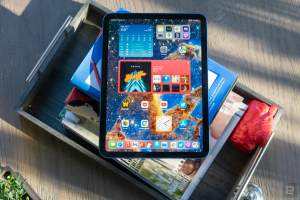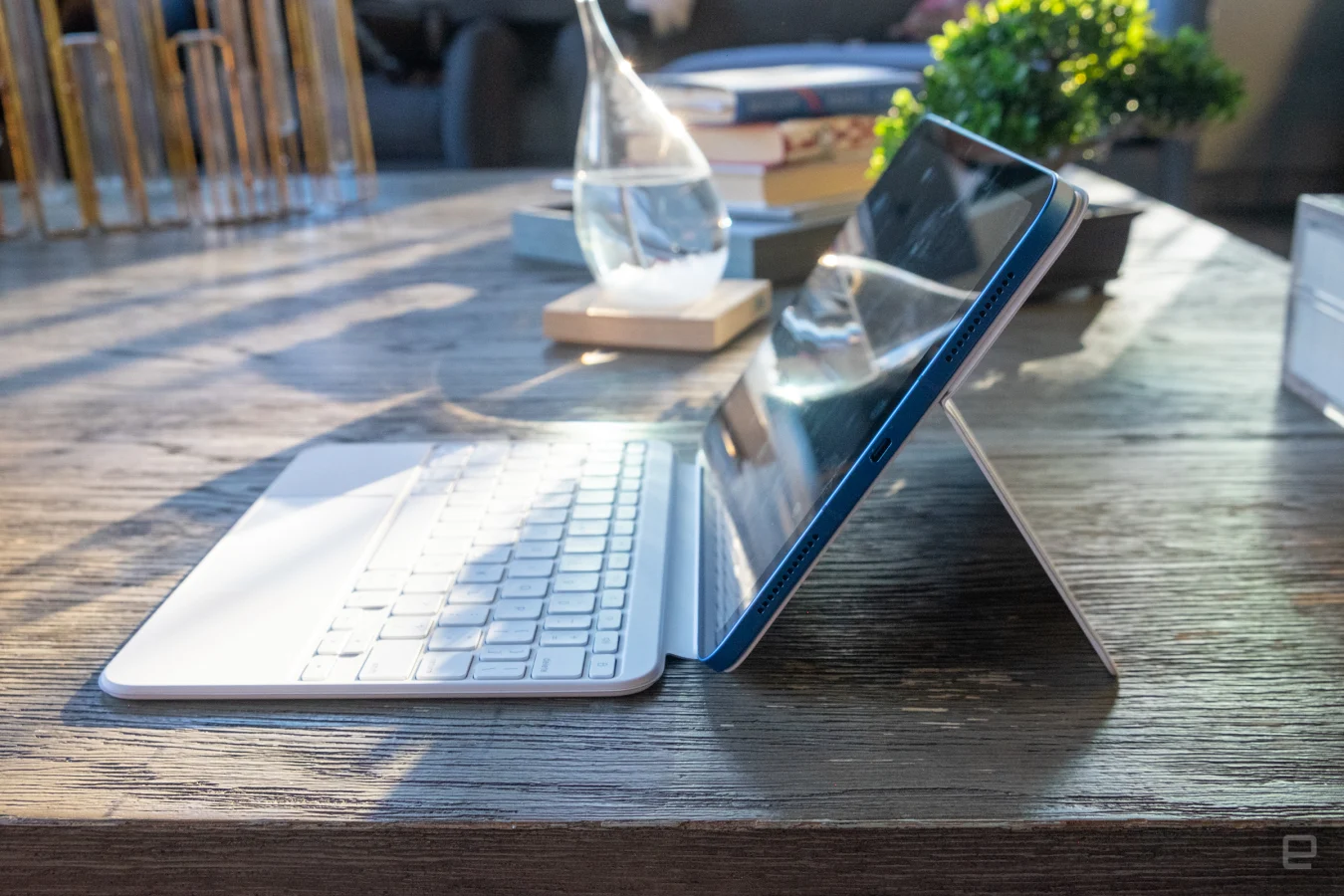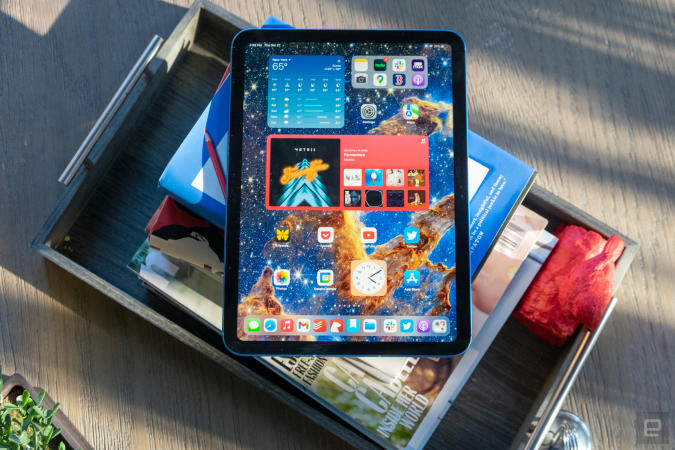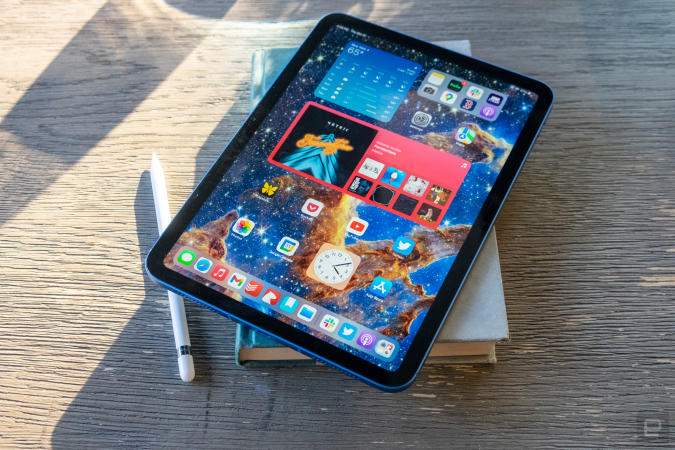(Engadget) Apple can rarely leave well enough alone.
A year ago, I thought each of the four tablets in the iPad lineup was differentiated well from the others, and it was fairly easy to see what features you got as things got more expensive. The new 10th-generation iPad throws a wrench in things, though. It’s a complete redesign from last year’s model that cribs heavily from the iPad Air while also bringing a handful of compromises to upsell potential customers on Apple’s more expensive tablets.
But the new iPad also contains a few puzzling decisions and a $120 price hike — the base model now costs $449. Muddying the waters further, last year’s iPad remains available at $329. And while I think the improvements Apple made to the 10th-generation iPad are significant, I’m not sure how many people in the market for an inexpensive tablet will find these changes worth their cash.

Unlike last year’s iPad, which looked essentially identical to the basic tablet Apple has been selling since 2017, this year’s model has been completely redesigned. The Home button is gone, Touch ID has moved to the lock button, the bezels are smaller, the display is bigger, the edges are squared off and the front-facing camera has been moved to the iPad’s landscape edge. It’s a significant set of changes — but only if you haven’t seen an iPad Pro or Air in recent years. Apple has been making tablets with most of these design elements since 2018, so it’s not exactly a fresh look. While it’s slightly thicker and larger than the iPad Air I reviewed earlier this year, it feels essentially identical in the hand, with the exact same size screen.
Gallery: Apple 10th-generation iPad review photos | 12 Photos
Inside the iPad is an A14 Bionic chip (first seen in 2020’s iPhone 12 lineup), a modest update over the A13 in last year’s model. It’s a strong performer, but it wasn’t all that slow to begin with. Of course, if you’re going to raise the price, you had better increase the performance. My modest work needs (Slack, Safari, Google Docs, Todoist, Gmail, etc.) didn’t tax the iPad in the least. Nor did any of the Apple Arcade games I played, and more advanced tasks like editing RAW photos in Lightroom or transcoding and exporting 4K video clips in 1080p were similarly smooth. Sure, the A14 trails the M1 in the iPad Air and the M2 in the new iPad Pro, but the vast majority of iPad buyers will be plenty happy.
There is one catch with the A14: this iPad can’t use the new Stage Manager multitasking and window-management features that are in iPadOS 16, as they’re limited to iPad Pro models from 2018 and later or the M1-powered iPad Air.
As for battery life, Apple continues to meet or exceed its 10-hour estimate it provides for every iPad. This model lasted 11 hours and 45 minutes while playing back a movie purchased from the iTunes Store. I didn’t quite hit 10 hours when using the iPad and its keyboard for work all day long, but it was close enough that I’m not complaining. Of course, more intensive tasks like gaming or editing video will reduce that time significantly.
 Image Credit: Nathan Ingraham / Engadget
Image Credit: Nathan Ingraham / Engadget
Screen
Compared to last year’s iPad, the screen here is definitely bigger, but not better in any measurable way. It’s the same 10.9 inches as the iPad Air (up from 10.2 inches), and that does make working with multiple apps feel a bit less cramped. And a bigger screen in a body that’s essentially the same size is always a nice improvement. But, this display still lacks a lot of the niceties you’ll find on the Air. Specifically, the display isn’t laminated to the front glass, it’s missing an anti reflective coating and it doesn’t support the P3 wide color gamut.
These missing features were easier to ignore when it cost $329, but this new iPad only costs $150 less than the Air. That’s not to say this display is bad, but it’s clearly the worst in the iPad lineup — and its deficiencies are a lot more glaring at a higher price. I noticed the air gap between the screen and cover glass less than I expected, but it was a lot more noticeable when I held the iPad in my hands and moved compared to using it with the Magic Keyboard Folio.

Nathan Ingraham / Engadget
Keyboard
Speaking of the keyboard, the new iPad has its own redesigned accessory here. The Magic Keyboard Folio is two separate pieces: a back that magnetically attaches and has a kickstand, and a keyboard that attaches to the side of the iPad. It then uses the Smart Connector located on its edge to sync and power the keyboard.
The folio design has one big deficiency compared to the Magic Keyboard for the iPad Air and Pro. That keyboard is much better for lap typing. The folio, on the other hand, is not nearly as stable on your lap. Fortunately, the typing experience itself is much better than the old Smart Keyboard Cover that works with last year’s iPad. These keys have 1mm of travel, there’s a 14-key function row up top (the first Apple-made iPad keyboard to offer them) and the trackpad is large and responsive. It’s even bigger than the trackpad on the more expensive Magic Keyboard.
While I don’t care to use a folio-style keyboard on my lap, it was totally fine for long typing sessions at my desk. And the bigger trackpad and function keys are major improvements that I hope to see implemented on other iPad keyboards soon.
The elephant in the room is that this keyboard costs a truly painful $250; this means that the basic iPad with 64GB of storage and this Magic Keyboard Folio would cost $700. That’s a wild amount of money, and you could get an iPad Air and the second-generation Apple Pencil for just a little bit more, or pick up a solid Windows laptop if you’re going to be doing a lot of typing.
Cameras
Apple also made some significant improvements to the camera system on the new iPad. It now has the same 12-megapixel back camera as the Air. It’s not the best camera out there; as I always say, chances are good the camera on the phone in your pocket is better. But for anyone who wants to shoot video, it now offers 4K capture while last year’s model maxed out at 1080p.
More significant is the front-facing camera. Oddly enough, it’s exactly the same as last year’s – with one notable exception. Apple finally put the front-facing camera on the landscape edge of the iPad, which means your face will actually be centered if you’re taking a video call with the iPad in its keyboard folio (or just propped up with the kickstand). Amazingly, this iPad is the only one with this feature. The iPad Pro, the best tablet Apple sells, still has its camera on the portrait edge. Basic iPad buyers win out here.









